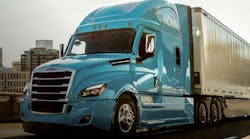Daimler Truck North America will be prepared to respond to any surge in purchase orders before the 2027 introduction of more stringent California emissions standards, CEO and interim CFO Martin Daum told analysts and investors March 1.
“We have a great position, we have great products, we are prepared for any regulation,” Daum said at the presentation of Daimler Truck’s fourth-quarter and full-year results. “I am absolutely confident that we will master any reaction of the markets […] Certainly if we see in ’25 and ’26 a pull-forward effect, we’ll take it and go from there.”
Daum didn’t say he expects to see fleets ramping up orders ahead of the California Air Resources Board’s stricter rules, which will align with 2027 nitrogen oxide emissions standards laid out by the U.S. Environmental Protection Agency. He noted that the relative strength of the U.S. economy will be a significant factor in order flow in the coming years, a comment that piggybacked on the 2024 outlook of Daimler executives—and their main peers—for flat volumes.
Daimler Truck’s operations in North America sold about 48,250 units in the last three months of 2023, a year-over-year drop of 4%, and range-up revenues of roughly $6.5 billion that were down 3% from late 2022. With adjusted EBITDA declining by 2% to nearly $780 million, the division had better material costs and pricing, even though Daum said his team passed on hiking prices more and likely will hold the line this year despite continued supply-chain hiccups and cost pressures, particularly when it comes to labor.
For the full year, Daimler Truck North America sold more than 195,000 vehicles, up more than 4% from the prior 12 months, and revenues of $23.5 billion versus $22.0 billion. The group finished the year with an operating margin of 12.3%, up from 10.8% in 2022 and above the 11.5% it posted in 2019 before the pandemic disrupted the business.
See also: Cummins, Daimler, and Paccar detail massive battery plant plans
Daum and his team see those numbers holding steady in 2024: They are forecasting unit sales of 180,000 to 200,000 and guiding to margins of 11% to 13%, in line with last year’s. Customer activity, he said, continues to normalize after several years of aggressive fleet replenishment and upgrades and in the face of growing economic uncertainty.
“Customers are now ordering the vehicles when they need them rather than reserving slots far in advance,” Daum said, adding that North American production is almost sold out for the first half of this year.
Within that order flow, Daum said, are nuances that include less demand for on-highway trucks that Daimler has reacted to by shifting more resources toward building vehicles for the construction, utilities, and body-builders segments as greater infrastructure spending flows through the system. Building on comments he made in November about growing the capacity of the company’s Western Star brand, Daum said a plant in Cleveland, North Carolina, that four years ago was dedicated solely to on-highway trucks will this year be 100% geared to making Western Star models. The DTNA team, he added, is also still looking for additional capacity options.
The Frankfurt-listed shares of Daimler Truck (Ticker: DTG) jumped 18% on the fourth-quarter report, which included word of a big dividend hike. Over the past six months, they have climbed about 40%, growing the company’s market capitalization to more than $36 billion.



